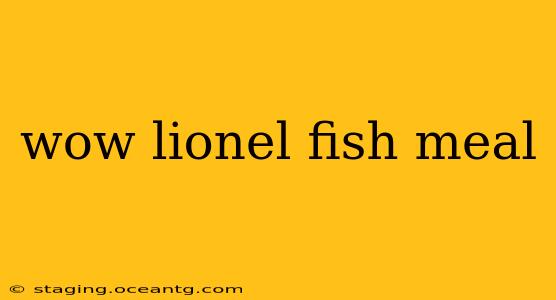Wow, Lionel Fish Meal: A Deep Dive into a Sustainable Seafood Option
The phrase "Wow, Lionel Fish Meal" likely stems from a surprise or positive reaction to discovering this specific brand or type of fish meal. While "Lionel" isn't a widely recognized brand name in the fish meal industry, it highlights the growing consumer interest in sustainable and high-quality seafood products. This article delves into the world of fish meal, exploring its uses, benefits, and crucial considerations for environmentally conscious consumers. We'll also address some common questions surrounding fish meal production and consumption.
What is Fish Meal?
Fish meal is a product derived from processing fish and other marine organisms. It's created by drying and grinding various fish parts, including those typically discarded in other fishing processes. This makes it a relatively sustainable byproduct, utilizing parts that might otherwise go to waste. The resulting powder is rich in protein and essential nutrients, making it a valuable ingredient in various applications.
What are the Uses of Fish Meal?
The primary use of fish meal is as a feed ingredient for aquaculture (fish farming) and livestock. Its high protein content and amino acid profile contribute to faster growth and improved health in farmed animals. However, the use of fish meal in animal feed is a subject of ongoing debate regarding sustainability, a topic we'll explore further below.
Beyond animal feed, fish meal also finds application in fertilizers, enriching the soil with valuable nutrients. Some niche markets utilize fish meal in pet food and even certain human food products, though this is less common.
Is Fish Meal Sustainable?
This is a critical question, and the answer isn't a simple yes or no. The sustainability of fish meal production hinges heavily on the sourcing of the raw materials. Overfishing and unsustainable fishing practices can severely deplete fish stocks, leading to negative environmental consequences. Therefore, choosing fish meal derived from certified sustainable fisheries is crucial. Look for certifications like the Marine Stewardship Council (MSC) label, which signifies that the fish used were caught responsibly.
Moreover, the environmental impact also depends on the processing methods used. Modern fish meal production facilities strive to minimize waste and energy consumption, improving their overall ecological footprint.
What are the Benefits of Using Fish Meal?
- High protein content: Fish meal is exceptionally rich in protein, making it a valuable source of this essential nutrient for animals and plants.
- Essential amino acids: It contains a complete profile of essential amino acids, vital for growth and development.
- Nutrient-rich: Besides protein, fish meal provides other essential nutrients, such as omega-3 fatty acids (though the quantity can vary depending on the source fish), minerals, and vitamins.
- Improved animal feed efficiency: In aquaculture and livestock, fish meal can improve feed conversion ratios, meaning animals require less feed to achieve the same growth rate.
- Soil enrichment: As a fertilizer, fish meal improves soil fertility and enhances plant growth.
What are the Drawbacks of Using Fish Meal?
- Sustainability concerns: As mentioned earlier, the sustainability of fish meal depends heavily on responsible sourcing. Unsustainable practices can contribute to overfishing and habitat destruction.
- Potential for heavy metals: Fish meal can accumulate heavy metals from the environment, which can pose health risks if not properly managed during processing.
- Allergenicity: In some individuals, fish meal can cause allergic reactions.
- Cost: Fish meal can be relatively expensive compared to other protein sources.
Where Can I Find Sustainable Fish Meal?
Identifying truly sustainable fish meal requires diligent research. Look for products with certifications from reputable organizations like the MSC. Check the labeling for information on the source of the fish and the processing methods used. Directly contacting the supplier or manufacturer for further information can also be beneficial.
Is Fish Meal Safe for Human Consumption?
While fish meal is primarily used in animal feed, it’s technically safe for human consumption in certain processed forms. However, it's not typically a primary ingredient in human food due to its taste and texture. Its nutritional value is certainly significant, but other, more palatable, fish products are generally preferred for direct human consumption.
By understanding the nuances of fish meal production and its various aspects, consumers can make informed choices that support both their needs and the health of our oceans. The "Wow" factor in the initial phrase may be a reflection of discovering a high-quality, sustainably produced option, a critical factor in ensuring the long-term availability of this valuable resource.
